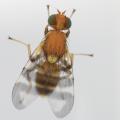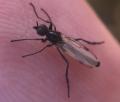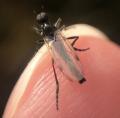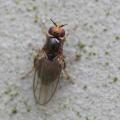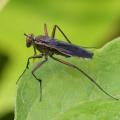Diptera.info :: Identification queries :: Diptera (adults)
Who is here? 1 guest(s)
|
Tachinidae - Oswaldia muscaria prob.
|
|
| tim worfolk |
Posted on 09-05-2009 06:11
|
|
Member Location: Devon, England Posts: 737 Joined: 05.05.09 |
Tachinidae surely, but is it possible to id. to genus, or even sp.? Photographed in mixed woodland/rough grass, Devon, England.
tim worfolk attached the following image: 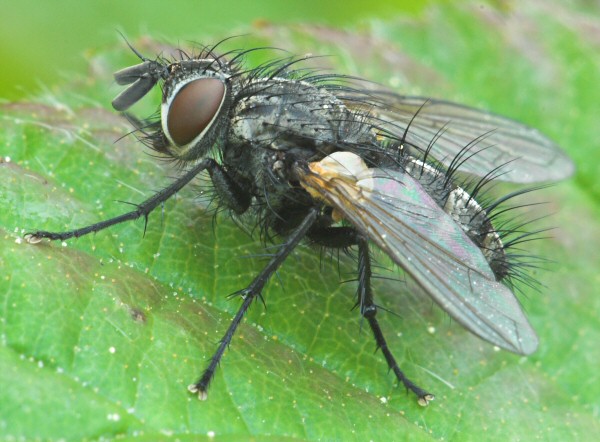 [126.07Kb] Edited by tim worfolk on 05-06-2009 07:46 |
|
|
|
| Zeegers |
Posted on 09-05-2009 07:56
|
|
Member Location: Soest, NL Posts: 18539 Joined: 21.07.04 |
First impression is Oswaldia muscaria, which agrees with the habitat given. Can't be 100 % sure with this one pic. Theo |
|
|
|
| ChrisR |
Posted on 09-05-2009 07:57
|
|
Administrator Location: Reading, England Posts: 7699 Joined: 12.07.04 |
Would be a nice record for the UK - Oswaldia isn't exactly "rare" but it isn't common either  Theo: would I be right in saying that the main feature that makes you think of Oswaldia would be the humeral callus bristles formed into a triangle ... and the fact that it obviously isn't Nemorilla? Edited by ChrisR on 09-05-2009 07:59 Manager of the UK Species Inventory in the Angela Marmont Centre for UK Biodiversity at the Natural History Museum, London. |
| Zeegers |
Posted on 09-05-2009 08:09
|
|
Member Location: Soest, NL Posts: 18539 Joined: 21.07.04 |
First of all: the apical scutellars are missing, which is a rare thing in Eryciini/Goniini. So one has a look at the wing venation: difficult to see, but first impression is Blondeliini (that is, bend in vein M curved, not angular). There are only 3 post DC, again, very unusual in Goniini/Eryciini. Just to be sure: can't think of any Exoristini like this, so, it must be Blondeliini. Then: eyes bare, humeri in a triangle as you correctly observed, tibia 2 with several ad bristles, lateral scutellar bristles long. Moreover, the face has hairs on its lower half, quite characteristic for Oswaldia muscaria. third antennal segment long. SO, if it is not something weirdo, it is Oswaldia muscaria. I'm pretty confident it is, however, strictly speaking, I'm not 100 % sure. If Phorocera obscura is not already very common, no wonder Oswaldia isn't either. They live in the same habitat: deciduous forests. Oswaldia is slightly later in the year. Nemorilla has very long hairs on the eye. Theo |
|
|
|
| ChrisR |
Posted on 09-05-2009 08:26
|
|
Administrator Location: Reading, England Posts: 7699 Joined: 12.07.04 |
Well, areas like the south-west of England have the advantage of having larger tracts of unspoilt land and more high-quality hedges and small woodlands etc. Here in the center and south-east we have lost a lot of habitats to agriculture, housing & roads over the last 50 years ... all classed as "development" projects  It has got to such a sad level that butterfly species like Aglais urticae (Small Tortoishell) have declined catastrophically in recent years in central/southern England so that now it is almost a rarity! Some areas still have good populations but I believe these are areas that also have the best areas of countryside and marginal habitats too - such as the county of Dorset and in the north. What annoys me most is that some people seem to have ignored the issue of massive habitat decline and instead have been suggesting that the arrival of the parasitoid Sturmia bella might have been the "cause". A far more balanced view would seem to be that 95% of the decline is due to the horrific mismanagement of our countryside ... grrrr 
Manager of the UK Species Inventory in the Angela Marmont Centre for UK Biodiversity at the Natural History Museum, London. |
| tim worfolk |
Posted on 09-05-2009 08:33
|
|
Member Location: Devon, England Posts: 737 Joined: 05.05.09 |
Thanks guys, for your replies. I didn't get shots from angles other than this but I do have much higher res. pictures if close-ups might help. Also found this individual nearby, a few minutes later - although I suspect it might not be the same sp. as eyes rather hairy. tim worfolk attached the following image:  [114.18Kb] |
|
|
|
| ChrisR |
Posted on 09-05-2009 08:36
|
|
Administrator Location: Reading, England Posts: 7699 Joined: 12.07.04 |
A tachinid but definitely not the same species - should really go on its own thread  But to me it looks a bit like Lypha dubia - a fairly common Spring species. Theo will probably prove me wrong though! 
Manager of the UK Species Inventory in the Angela Marmont Centre for UK Biodiversity at the Natural History Museum, London. |
| Jump to Forum: |




